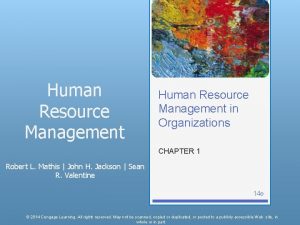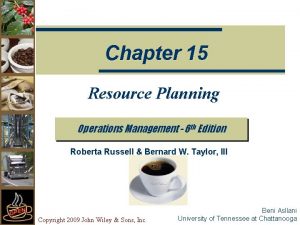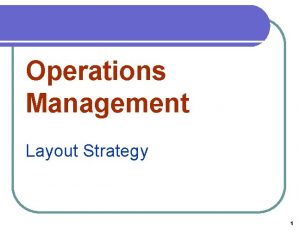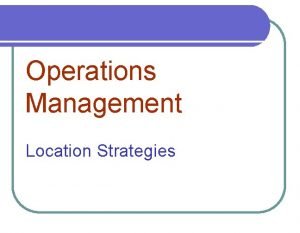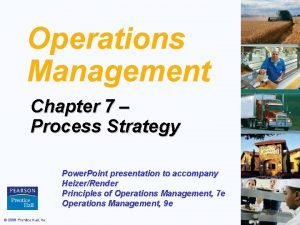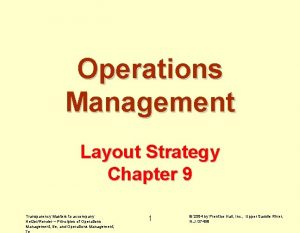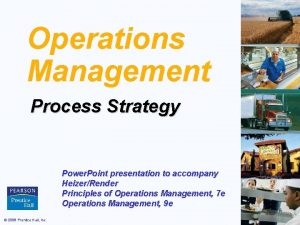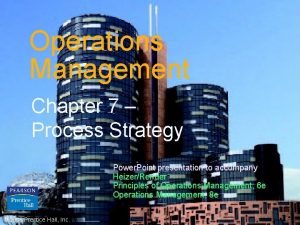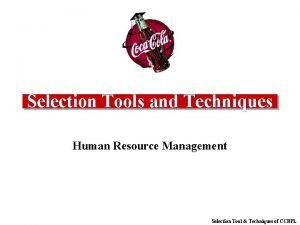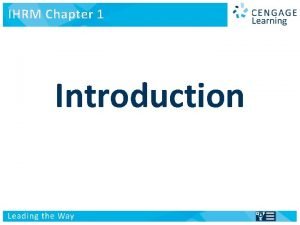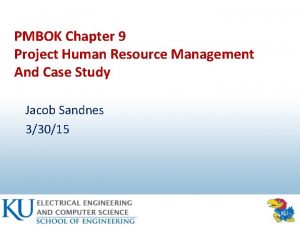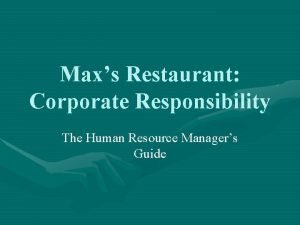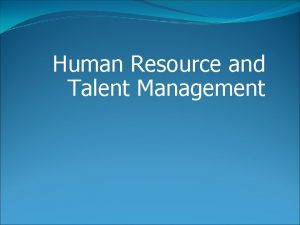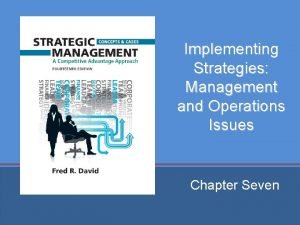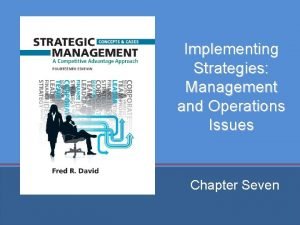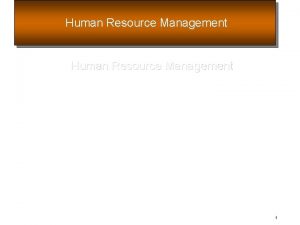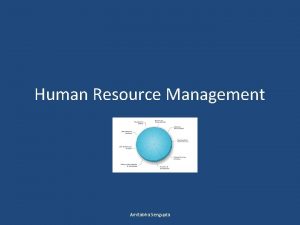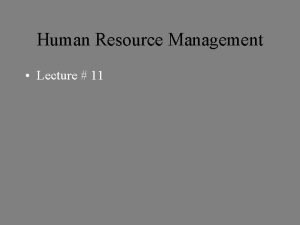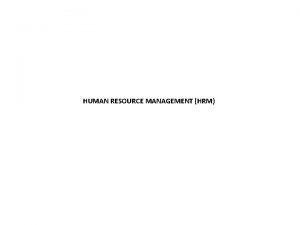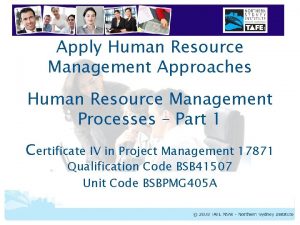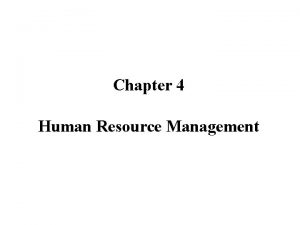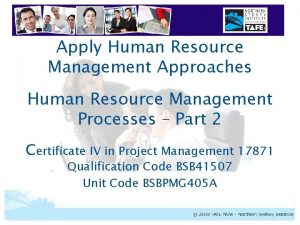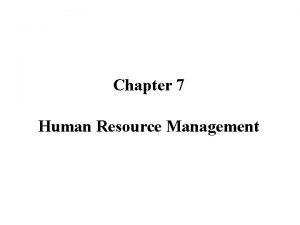Implementing Strategies Management Operations and Human Resource Issues






































- Slides: 38

Implementing Strategies: Management, Operations, and Human Resource Issues Chapter Seven Copyright © 2017 Pearson Education, Inc. 7 -1

Learning Objectives 1. Describe the transition from formulating to implementing strategies. 2. Discuss five reasons why annual objectives are essential for effective strategy implementation. 3. Identify and discuss six reasons why policies are essential for effective strategy implementation. 4. Explain the role of resource allocation and managing conflict in strategy implementation. 5. Discuss the need to match a firm’s structure with its strategy. Copyright © 2017 Pearson Education, Inc. 7 -2

Learning Objectives (cont. ) 6. Identify, diagram, and discuss seven different types of organizational structure. 7. Identify and discuss fifteen dos and don’ts in constructing organizational charts. 8. Discuss four strategic production/operations issues vital for successful strategy implementation. 9. Discuss seven strategic human resource issues vital for successful strategy implementation. Copyright © 2017 Pearson Education, Inc. 7 -3

Comprehensive Strategic. Management Model Copyright © 2017 Pearson Education, Inc. 7 -4

The Nature of Strategy Implementation Strategy Formulation Strategy Implementation v Strategy formulation is positioning forces before the action. v Strategy formulation focuses on effectiveness. v Strategy formulation is primarily an intellectual process. v Strategy formulation requires good intuitive and analytical skills. v Strategy implementation is managing forces during the action. v Strategy implementation focuses on efficiency. v Strategy implementation is primarily an operational process. v Strategy implementation requires special motivation and leadership skills. Copyright © 2017 Pearson Education, Inc. 7 -5

Annual Objectives: 1. Represent the basis for allocating resources 2. Are a primary mechanism for evaluating managers 3. Are the major instrument for monitoring progress toward achieving long-term objectives 4. Establish organizational, divisional, and departmental priorities 5. Are essential for keeping a strategic plan on track Copyright © 2017 Pearson Education, Inc. 7 -6

The Stamus Company’s Hierarchy of Aims 7 -7

Policies v. Policy vspecific guidelines, methods, procedures, rules, forms, and administrative practices established to support and encourage work toward stated goals vinstruments for strategy implementation Copyright © 2017 Pearson Education, Inc. 7 -8

Policies vset boundaries, constraints, and limits on the kinds of administrative actions that can be taken to reward and sanction behavior vlet both employees and managers know what is expected of them, thereby increasing the likelihood that strategies will be implemented successfully vprovide a basis for management control and allow coordination across organizational units Copyright © 2017 Pearson Education, Inc. 7 -9

Policies v. Policies (cont. ) vreduce the amount of time managers spend making decisions. Policies also clarify what work is to be done and by whom. vpromote delegation of decision making to appropriate managerial levels where various problems usually arise. vclarify what can and cannot be done in pursuit of an organization’s objectives. Copyright © 2017 Pearson Education, Inc. 7 -10

Types of Resources Financial Physical Human Technological Copyright © 2017 Pearson Education, Inc. 7 -11

Resource Allocation vcentral management activity that allows for strategy execution v. Strategic management enables resources to be allocated according to priorities established by annual objectives Copyright © 2017 Pearson Education, Inc. 7 -12

Managing Conflict vdisagreement between two or more parties on one or more issues v. Establishing annual objectives can lead to conflict because individuals have different expectations and perceptions, schedules create pressure, personalities are incompatible, and misunderstandings occur between line managers and staff managers Copyright © 2017 Pearson Education, Inc. 7 -13

Managing Conflict v. Avoidance vincludes such actions as ignoring the problem in hopes that the conflict will resolve itself or physically separating the conflicting individuals v. Defusion vincludes playing down differences between conflicting parties while accentuating similarities and common interests Copyright © 2017 Pearson Education, Inc. 7 -14

Managing Conflict v. Confrontation vexemplified by exchanging members of conflicting parties so that each can gain an appreciation of the other’s point of view or holding a meeting at which conflicting parties present their views and work through their differences Copyright © 2017 Pearson Education, Inc. 7 -15

Some Management Trade-Off Decisions Required in Strategy Implementation Copyright © 2017 Pearson Education, Inc. 7 -16

Matching Structure With Strategy v. Structure largely dictates how objectives and policies will be established v. Structure dictates how resources will be allocated Copyright © 2017 Pearson Education, Inc. 7 -17

Symptoms of an Ineffective Organizational Structure Copyright © 2017 Pearson Education, Inc. 7 -18

The Functional Structure vgroups tasks and activities by business function, such as production/operations, marketing, finance/accounting, research and development, and management information systems Copyright © 2017 Pearson Education, Inc. 7 -19

Advantages and Disadvantages of a Functional Organizational Structure Copyright © 2017 Pearson Education, Inc. 7 -20

Divisional Structure v. Functional activities are performed both centrally and in each separate division v. Organized by geographic area, product or service, customer, or process Copyright © 2017 Pearson Education, Inc. 7 -21

Advantages and Disadvantages of a Divisional Organizational Structure Copyright © 2017 Pearson Education, Inc. 7 -22

The Strategic Business Unit (SBU) Structure v. SBU Structure vgroups similar divisions into strategic business units and delegates authority and responsibility for each unit to a senior executive who reports directly to the chief executive officer vcan facilitate strategy implementation by improving coordination between similar divisions and channeling accountability to distinct business units Copyright © 2017 Pearson Education, Inc. 7 -23

The Matrix Structure vmost complex of all designs because it depends upon both vertical and horizontal flows of authority and communication Copyright © 2017 Pearson Education, Inc. 7 -24

The Matrix Structure v. For a matrix structure to be effective, organizations need participative planning, training, clear mutual understanding of roles and responsibilities, excellent internal communication, and mutual trust and confidence Copyright © 2017 Pearson Education, Inc. 7 -25

Advantages and Disadvantages of a Matrix Structure Copyright © 2017 Pearson Education, Inc. 7 -26

Typical Top Managers of a Large Firm 7 -27

Restructuring vinvolves reducing the size of the firm in terms of number of employees, number of divisions or units, and number of hierarchical levels in the firm's organizational structure vprimary benefit sought from restructuring is cost reduction Copyright © 2017 Pearson Education, Inc. 7 -28

Reengineering vinvolves reconfiguring or redesigning work, jobs, and processes for the purpose of improving cost, quality, service, and speed vdoes not usually affect the organizational structure or chart, nor does it imply job loss or employee layoffs Copyright © 2017 Pearson Education, Inc. 7 -29

Managing Resistance to Change v. Force Change Strategy vinvolves giving orders and enforcing those orders v. Educative Change Strategy vpresents information to convince people of the need for change v. Self-interest Change Strategy vattempts to convince individuals that the change is to their personal advantage Copyright © 2017 Pearson Education, Inc. 7 -30

Strategic Human Resource Issues v. Seven human resource issues: 1. 2. 3. 4. 5. 6. linking performance and pay to strategy balancing work life with home life developing a diverse work force using caution in hiring a rival’s employees creating a strategy-supportive culture using caution in monitoring employees’ social media 7. developing a corporate wellness program Copyright © 2017 Pearson Education, Inc. 7 -31

Linking Performance and Pay to Strategies v. Decisions on salary increases, promotions, merit pay, and bonuses need to support the long-term and annual objectives of the firm v. Gain sharing and bonus systems can be used Copyright © 2017 Pearson Education, Inc. 7 -32

Balance Work and Home Life v. Work and family strategies now represent a competitive advantage for those firms that offer such benefits as: velder care assistance vflexible scheduling vjob sharing vadoption benefits vonsite summer camp vemployee help line vpet care vlawn service referrals Copyright © 2017 Pearson Education, Inc. 7 -33

Develop a Diverse Workforce Six benefits of having a diverse workforce are: 1. Women and minorities have different insights, opinions, and perspectives that should be considered. 2. A diverse workforce portrays a firm committed to nondiscrimination. 3. A workforce that mirrors a customer base can help attract customers, build customer loyalty, and design/offer products/services that meet customer needs/wants. 4. A diverse workforce helps protect the firm against discrimination lawsuits. 5. Women and minorities represent a huge additional pool of qualified applicants. 6. A diverse workforce strengthens a firm’s social responsibility and ethical position Copyright © 2017 Pearson Education, Inc. 7 -34

Creating a Strategy-Supportive Culture 1. Formal statements of organizational philosophy, charters, creeds, materials used for recruitment and selection, and socialization 2. Designing of physical spaces, facades, buildings 3. Deliberate role modeling, teaching, and coaching by leaders 4. Explicit reward and status system, promotion criteria 5. Stories, legends, myths, and parables about key people and events Copyright © 2017 Pearson Education, Inc. 7 -35

Creating a Strategy-Supportive Culture 6. What leaders pay attention to, measure, and control 7. Leader reactions to critical incidents and organizational crises 8. How the organization is designed and structured 9. Organizational systems and procedures 10. Criteria used for recruitment, selection, promotion, leveling off, retirement, and “excommunication” of people Copyright © 2017 Pearson Education, Inc. 7 -36

Monitoring Social Media v. Proponents of companies monitoring employees’ social-media activities emphasize that v(1) a company’s reputation in the marketplace can easily be damaged by disgruntled employees venting on social media sites v(2) social-media records can be subpoenaed, like email, and used as evidence against the company. Copyright © 2017 Pearson Education, Inc. 7 -37

Corporate Wellness Program v. The Affordable Care Act increased the maximum incentives and penalties employers may use to encourage employee well-being v. Most companies have both v“carrots, ” such as giving employee discounts on insurance premiums or even extra cash, v“sticks, ” such as imposing surcharges on premiums for those who do not make progress toward getting healthy. Copyright © 2017 Pearson Education, Inc. 7 -38
 Implementing strategies management and operations issues
Implementing strategies management and operations issues Implementing strategies: management and operations issues
Implementing strategies: management and operations issues Chapter 7 strategic management
Chapter 7 strategic management Implementing strategies management and operations issues
Implementing strategies management and operations issues Ch 7
Ch 7 Job design continuum
Job design continuum Current issues in human resource management
Current issues in human resource management Designing and implementing brand architecture strategies
Designing and implementing brand architecture strategies Designing and implementing brand architecture
Designing and implementing brand architecture Low end entry level brand
Low end entry level brand Finance and accounting issues in strategy implementation
Finance and accounting issues in strategy implementation Time management human resources
Time management human resources Organized retail
Organized retail Function of personnel management
Function of personnel management Contemporary issues in management ppt
Contemporary issues in management ppt Why study operations management
Why study operations management Types of production process
Types of production process Resource planning in operations management
Resource planning in operations management Retail layout operations management
Retail layout operations management Location strategies in operations management
Location strategies in operations management Process strategy in operations management
Process strategy in operations management According to heizer and render, a retail/service layout
According to heizer and render, a retail/service layout Example of process strategy
Example of process strategy Crossover chart operations management
Crossover chart operations management The pricing tripod
The pricing tripod Hrm question paper
Hrm question paper Strategic human resource
Strategic human resource Define human resource management and payroll cycle
Define human resource management and payroll cycle Selection in human resource management
Selection in human resource management Hr selectietool
Hr selectietool Similarities between domestic and international hrm
Similarities between domestic and international hrm Environmental and resource efficiency issues
Environmental and resource efficiency issues Checklist model project management
Checklist model project management Resource management pmp
Resource management pmp Project human resource management pmbok
Project human resource management pmbok Importance in hrm
Importance in hrm Restaurant human resources
Restaurant human resources Human induction meaning
Human induction meaning Chapter 2 human resource management
Chapter 2 human resource management






